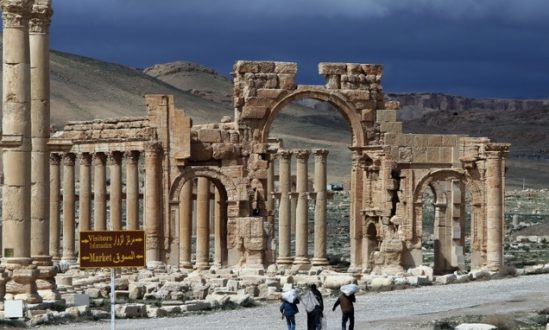Syria forces on brink of retaking iconic city of Palmyra from ISIS
Syrian pro-government forces have advanced to the edge of the famed ancient city of Palmyra today, a monitor said.
The move is a major symbolic victory over the Islamic State jihadist group, who seized control of the city in May last year.
The takeover sent shock waves around the world as the group demolished some of the most treasured monuments of its Unesco-listed World Heritage Site.

Islamic State fighters seized Palmyra, dubbed the ‘Pearl of the Desert’, in May 2015. Syrian pro-government forces are said to have now advanced to the edge of the city
‘The regime forces are now a little more than a mile away on the south side and three miles away on the west side,’ Syrian Observatory for Human Rights director Rami Abdel Rahmans said.
Regime forces launched an offensive to retake the city at the start of the month backed by heavy Russian air strikes.
Moscow said last week that it was flying up to 25 sorties a day to help government forces liberate what President Vladimir Putin described as a ‘pearl of world civilisation’.
But ISIS has fiercely resisted the advance, killing at least 26 pro-government fighters on Monday alone, the Observatory said.
Aamaq, an ISIS-linked news agency, claimed that 30 troops were killed in an attack by a jihadist suicide bomber.
ISIS has also claimed to have killed five Russian soldiers as well as fighters of Lebanese Shiite militant group Hezbollah in the battle for Palmyra.

The Islamic State group sent shock waves around the world as it demolished some of the most treasured monuments in Palmyra

A map showing the power struggle of different groups in Syria (correct as of early 2016)
But there has been no confirmation from Moscow of the deaths of any soldiers or even of the presence of any military advisers on the ground.
The Kremlin has said that the offensive is being carried out by the Syrian army.
The recapture of Palmyra would be a strategic as well as symbolic prize for the regime.
Whoever controls the oasis city also controls the surrounding desert -an area of some 12,000 square miles extending to the Iraqi border.
That would cut ISIS’s area of control from some 40 per cent of Syrian territory to 30 per cent, according to the Observatory.
Global concern for Palmyra’s magnificent ancient ruins spiked in September 2015, when satellite images confirmed that ISIS had demolished the famed Temple of Bel as part of its campaign to destroy pre-Islamic monuments it considers idolatrous.

ISIS has already destroyed the shrine of Baalshamin and the 2,000-year-old Temple of Bel, regarded as Palmyra’s masterpiece, as part of an ongoing campaign to destroy pre-Islamic monuments (pictured)

The Arch of Triumph, one of the most recognisable sites in the Syrian city of Palmyra (pictured before it was destroyed), has been blown up by ISIS extremists
Unesco described the temple as one of the best preserved and most important religious edifices of the first century in the Middle East.
In October, the jihadists blew up the Arch of Triumph, dating from between 193 and 211 AD, as they pressed a campaign of destruction that Unesco has said constitutes a war crime punishable by the International Criminal Court.
The jihadists have waged a sustained campaign of destruction against heritage sites in areas they control in Syria and Iraq and in August last year beheaded Palmyra’s 82-year-old former antiquities chief.
The city was a major centre of the ancient world as it lay on the caravan route linking the Roman Empire with Persia and the east.
Situated about 130 miles northeast of Damascus, it drew 150,000 tourists a year before it became engulfed by Syria’s devastating civil war.
Source: Syria forces on brink of retaking iconic city of Palmyra from ISIS | Daily Mail Online


